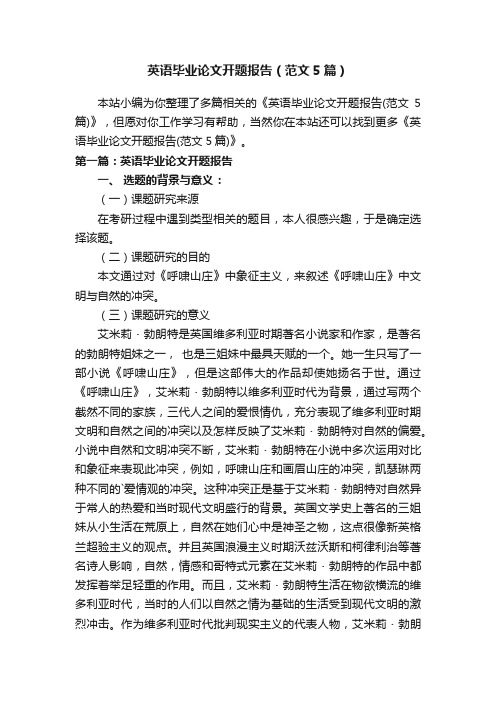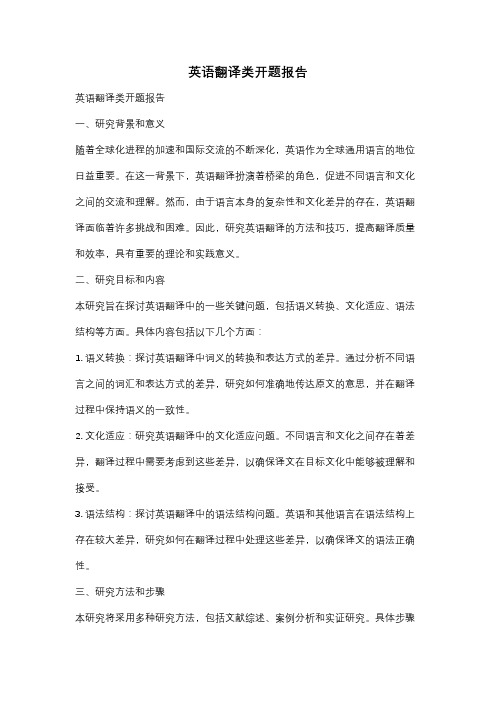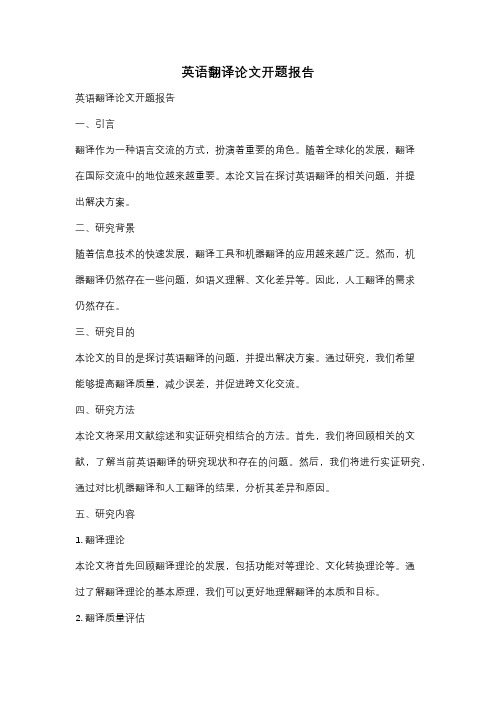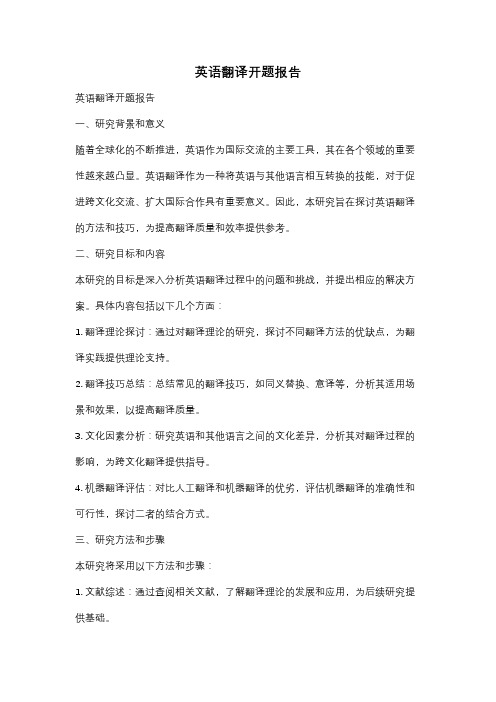翻译类英语论文开题报告
英语翻译方向的开题报告

英语翻译方向的开题报告英语翻译方向的开题报告一、选题背景及意义英语翻译作为一门重要的语言学科,对于促进不同国家和文化之间的交流与合作起着至关重要的作用。
随着全球化进程的加快,英语翻译的需求也越来越大,因此深入研究英语翻译方向的问题具有重要的理论和实践意义。
二、研究目的和研究问题本研究旨在探讨英语翻译方向的相关问题,包括翻译理论、翻译方法和翻译实践等方面。
具体研究问题如下:1. 英语翻译的理论基础是什么?2. 英语翻译的方法有哪些?各自的特点和适用场景是什么?3. 英语翻译实践中存在的问题有哪些?如何解决这些问题?通过对这些问题的研究,可以为英语翻译的发展提供理论指导和实践经验。
三、研究方法和步骤本研究将采用文献综述和实证研究相结合的方法,具体步骤如下:1. 收集相关文献,包括翻译理论、翻译方法和翻译实践方面的经典著作和最新研究成果。
2. 对文献进行综述和分析,总结英语翻译的理论基础和方法特点。
3. 结合实际案例,对英语翻译实践中存在的问题进行调研和分析。
4. 提出解决问题的建议和措施,为英语翻译实践提供参考和借鉴。
通过以上步骤,可以全面了解英语翻译方向的现状和问题,并提出有针对性的解决方案。
四、预期研究结果和创新点本研究预期将得出以下结果:1. 对英语翻译的理论基础进行梳理和总结,明确其核心概念和基本原则。
2. 对英语翻译的方法进行分类和评价,分析各自的特点和适用场景。
3. 对英语翻译实践中存在的问题进行深入分析,提出解决问题的建议和措施。
本研究的创新点在于对英语翻译方向的综合研究,将理论和实践相结合,旨在为英语翻译的发展提供理论指导和实践经验。
五、研究的局限性和可行性分析本研究的局限性主要体现在以下几个方面:1. 数据的获取和分析可能存在一定的困难,需要耗费一定的时间和精力。
2. 由于研究时间和资源的限制,无法对所有英语翻译方向的问题进行全面研究,可能只能选择一些典型问题进行深入分析。
然而,本研究的可行性较高,主要原因如下:1. 文献综述是一种常见的研究方法,相关文献资源丰富,易于获取和分析。
英语毕业论文开题报告(范文5篇)

英语毕业论文开题报告(范文5篇)本站小编为你整理了多篇相关的《英语毕业论文开题报告(范文5篇)》,但愿对你工作学习有帮助,当然你在本站还可以找到更多《英语毕业论文开题报告(范文5篇)》。
第一篇:英语毕业论文开题报告一、选题的背景与意义:(一)课题研究来源在考研过程中遇到类型相关的题目,本人很感兴趣,于是确定选择该题。
(二)课题研究的目的本文通过对《呼啸山庄》中象征主义,来叙述《呼啸山庄》中文明与自然的冲突。
(三)课题研究的意义艾米莉・勃朗特是英国维多利亚时期著名小说家和作家,是著名的勃朗特姐妹之一,也是三姐妹中最具天赋的一个。
她一生只写了一部小说《呼啸山庄》,但是这部伟大的作品却使她扬名于世。
通过《呼啸山庄》,艾米莉・勃朗特以维多利亚时代为背景,通过写两个截然不同的家族,三代人之间的爱恨情仇,充分表现了维多利亚时期文明和自然之间的冲突以及怎样反映了艾米莉・勃朗特对自然的偏爱。
小说中自然和文明冲突不断,艾米莉・勃朗特在小说中多次运用对比和象征来表现此冲突,例如,呼啸山庄和画眉山庄的冲突,凯瑟琳两种不同的`爱情观的冲突。
这种冲突正是基于艾米莉・勃朗特对自然异于常人的热爱和当时现代文明盛行的背景。
英国文学史上著名的三姐妹从小生活在荒原上,自然在她们心中是神圣之物,这点很像新英格兰超验主义的观点。
并且英国浪漫主义时期沃兹沃斯和柯律利治等著名诗人影响,自然,情感和哥特式元素在艾米莉・勃朗特的作品中都发挥着举足轻重的作用。
而且,艾米莉・勃朗特生活在物欲横流的维多利亚时代,当时的人们以自然之情为基础的生活受到现代文明的激烈冲击。
作为维多利亚时代批判现实主义的代表人物,艾米莉・勃朗特看到了现代文明带来的种种罪恶,内心更加执着于对自然的喜爱。
因此,要想真正读懂这部伟大的著作,就必须要了解小说中艾米莉・勃朗特对自然和文明的观点。
只有了解艾米莉・勃朗特对自然和文明的态度,才能真正明白在这爱恨情仇下有着更深刻的寓意-人类生活应该顺应自然和本性。
英语翻译类开题报告

英语翻译类开题报告英语翻译类开题报告一、研究背景和意义随着全球化进程的加速和国际交流的不断深化,英语作为全球通用语言的地位日益重要。
在这一背景下,英语翻译扮演着桥梁的角色,促进不同语言和文化之间的交流和理解。
然而,由于语言本身的复杂性和文化差异的存在,英语翻译面临着许多挑战和困难。
因此,研究英语翻译的方法和技巧,提高翻译质量和效率,具有重要的理论和实践意义。
二、研究目标和内容本研究旨在探讨英语翻译中的一些关键问题,包括语义转换、文化适应、语法结构等方面。
具体内容包括以下几个方面:1. 语义转换:探讨英语翻译中词义的转换和表达方式的差异。
通过分析不同语言之间的词汇和表达方式的差异,研究如何准确地传达原文的意思,并在翻译过程中保持语义的一致性。
2. 文化适应:研究英语翻译中的文化适应问题。
不同语言和文化之间存在着差异,翻译过程中需要考虑到这些差异,以确保译文在目标文化中能够被理解和接受。
3. 语法结构:探讨英语翻译中的语法结构问题。
英语和其他语言在语法结构上存在较大差异,研究如何在翻译过程中处理这些差异,以确保译文的语法正确性。
三、研究方法和步骤本研究将采用多种研究方法,包括文献综述、案例分析和实证研究。
具体步骤如下:1. 文献综述:对相关领域的文献进行综述,了解当前研究的进展和研究方法,为本研究提供理论基础和参考。
2. 案例分析:选择一些具有代表性的文本进行案例分析,分析其中的语义转换、文化适应和语法结构等问题。
通过对这些案例的分析,总结出一些通用的翻译方法和技巧。
3. 实证研究:通过实际的翻译实验,验证所提出的方法和技巧的有效性和可行性。
选择一些翻译难度较高的文本,进行翻译和评估,以验证所提出的方法和技巧的实际效果。
四、预期成果和应用价值本研究的预期成果包括以下几个方面:1. 理论贡献:通过对英语翻译中的关键问题进行深入研究,提出一些新的理论观点和方法,丰富和完善英语翻译的理论体系。
2. 实践指导:通过实证研究和案例分析,总结出一些通用的翻译方法和技巧,为英语翻译实践提供指导和参考。
英语翻译论文开题报告

英语翻译论文开题报告英语翻译论文开题报告一、引言翻译作为一种语言交流的方式,扮演着重要的角色。
随着全球化的发展,翻译在国际交流中的地位越来越重要。
本论文旨在探讨英语翻译的相关问题,并提出解决方案。
二、研究背景随着信息技术的快速发展,翻译工具和机器翻译的应用越来越广泛。
然而,机器翻译仍然存在一些问题,如语义理解、文化差异等。
因此,人工翻译的需求仍然存在。
三、研究目的本论文的目的是探讨英语翻译的问题,并提出解决方案。
通过研究,我们希望能够提高翻译质量,减少误差,并促进跨文化交流。
四、研究方法本论文将采用文献综述和实证研究相结合的方法。
首先,我们将回顾相关的文献,了解当前英语翻译的研究现状和存在的问题。
然后,我们将进行实证研究,通过对比机器翻译和人工翻译的结果,分析其差异和原因。
五、研究内容1. 翻译理论本论文将首先回顾翻译理论的发展,包括功能对等理论、文化转换理论等。
通过了解翻译理论的基本原理,我们可以更好地理解翻译的本质和目标。
2. 翻译质量评估翻译质量是翻译工作的核心问题。
本论文将探讨翻译质量评估的方法和标准,如BLEU、TER等。
通过评估翻译质量,我们可以了解翻译的准确性和流畅性,并找出改进的方向。
3. 机器翻译的问题与挑战尽管机器翻译在某些方面取得了很大的进展,但仍然存在一些问题和挑战。
本论文将分析机器翻译的问题,如语义理解、文化差异等,并提出解决方案。
4. 人工翻译的优势与局限与机器翻译相比,人工翻译具有一定的优势,如更好的语义理解和文化适应性。
然而,人工翻译也存在一些局限性。
本论文将探讨人工翻译的优势与局限,并提出改进的方法。
六、预期结果通过对英语翻译的研究,我们预期可以提出一些改进机器翻译和人工翻译的方法,以提高翻译质量。
我们还希望能够促进跨文化交流,减少误解和误译。
七、论文结构本论文将分为以下几个部分:1. 引言:介绍研究背景、目的和方法。
2. 翻译理论:回顾翻译理论的发展和基本原理。
翻译方向论文开题报告

翻译方向论文开题报告翻译方向论文开题报告一、研究背景和意义翻译作为一种跨文化交际工具,在国际交流中起着重要的作用。
随着全球化的发展和国际交往的频繁,翻译的需求不断增加。
然而,翻译并非简单的语言转换,而是一种复杂的文化传递过程。
因此,研究翻译方向对于提高翻译质量、促进跨文化交流具有重要意义。
二、研究目的和研究问题本研究旨在探讨翻译方向的相关问题,以提高翻译质量和效率。
具体研究问题包括但不限于:1. 翻译方向对翻译质量的影响;2. 翻译方向的选择与翻译效率的关系;3. 不同语言间翻译方向的异同。
通过对这些问题的研究,可以为翻译实践提供理论指导,提高翻译质量和效率。
三、研究方法本研究将采用多种研究方法,包括文献综述、实证研究和对比分析等。
首先,通过文献综述,了解翻译方向的相关理论和研究现状。
然后,进行实证研究,通过实际翻译案例,分析翻译方向对翻译质量的影响,并探讨翻译方向的选择与翻译效率的关系。
最后,进行对比分析,比较不同语言间翻译方向的异同,寻找共性和差异。
四、预期结果本研究预期将得出以下结果:1. 翻译方向对翻译质量有一定影响,不同方向可能存在优劣之分;2. 翻译方向的选择与翻译效率有一定关系,不同方向可能影响翻译速度和准确度;3. 不同语言间翻译方向存在一定的异同,可能受到语言结构和文化差异的影响。
五、研究意义和应用前景本研究的意义在于提高翻译质量和效率,促进跨文化交流。
通过深入研究翻译方向的相关问题,可以为翻译实践提供理论指导,帮助翻译人员更好地选择翻译方向,提高翻译质量。
同时,研究结果还可为翻译工具和机器翻译的开发提供参考,提高翻译效率。
六、研究计划本研究计划分为以下几个阶段:1. 阶段一:文献综述。
对翻译方向的相关理论和研究现状进行综述,明确研究问题和研究目标。
2. 阶段二:实证研究。
通过实际翻译案例,分析翻译方向对翻译质量的影响,并探讨翻译方向的选择与翻译效率的关系。
3. 阶段三:对比分析。
翻译论文开题报告范文

翻译论文开题报告范文翻译论文开题报告范文一、研究背景和意义在全球化的今天,跨文化交流和合作日益频繁,翻译作为一种重要的语言交流工具发挥着重要作用。
翻译论文作为研究翻译理论和实践的重要途径之一,对于提高翻译质量、推动翻译事业发展具有重要意义。
本文旨在探讨翻译论文的开题报告范文,帮助研究者更好地开展翻译论文的研究。
二、研究目的和方法本研究旨在通过分析翻译论文开题报告范文,总结出一套规范的开题报告写作方法,以提高翻译论文的质量和可读性。
本研究将采用文献研究法和实证研究法相结合的方法进行研究。
三、研究内容和计划1. 翻译论文开题报告的基本要素翻译论文开题报告通常包括研究背景、研究目的、研究方法、研究内容和计划等基本要素。
在撰写开题报告时,需要明确研究的背景和意义,明确研究目的和方法,详细说明研究内容和计划。
2. 翻译论文开题报告的结构和写作技巧翻译论文开题报告的结构通常包括引言、文献综述、研究问题、研究方法、预期结果和研究计划等部分。
在写作开题报告时,需要注意逻辑清晰,段落过渡自然,语言简明扼要。
同时,还需要注重文献综述的准确性和全面性,以支持研究的可行性和创新性。
3. 翻译论文开题报告的范文分析通过对已有翻译论文开题报告范文的分析,可以发现其共同之处和不足之处。
范文中通常包括对研究背景的介绍、对研究问题的提出、对研究方法的选择、对预期结果的展望以及对研究计划的安排等内容。
通过分析这些范文,可以总结出一套规范的开题报告写作方法,以提高翻译论文的质量和可读性。
四、研究预期结果和意义本研究预期通过分析翻译论文开题报告范文,总结出一套规范的开题报告写作方法,以提高翻译论文的质量和可读性。
这对于研究者来说具有重要意义,可以帮助他们更好地开展翻译论文的研究,提高研究水平和学术影响力。
五、研究的局限性和拓展方向本研究主要关注翻译论文开题报告的范文分析和写作方法总结,对于翻译论文的其他部分和写作技巧并未深入探讨。
未来的研究可以进一步拓展,探讨翻译论文的其他写作要点和技巧,以丰富研究内容和方法。
英语翻译专业本科生毕业论文开题报告(共9篇)

英语翻译专业本科生毕业论文开题报告(共9篇):开题本科生毕业论文英语翻译报告论文开题报告怎么写开题报告范文本科生毕业论文多少字篇一:英语专业本科毕业论文开题报告选题论证一、题目:The C-E Translation of Chinese Typical Expressions in theGovernment Work Reports from the Perspective of Skopos Theory二、我国研究现状中国政府每年都要在“两会”上向与会代表和委员发布《政府工作报告》,总结前一年或者前五年中国在建设具有中国特色的社会主义道路上所取得的新成就,同时部署来年或者未来五年中国政府对中国国情所作出的各项方针政策,涉及政治、经济、文化和人民生活等各个领域。
该报告也因此成为国际社会了解中国国情、中国发展、中国政府的政策和主张的尤为重要的途径之一,受到全世界各国政府和人民的普遍关注。
因此,其翻译的好坏直接影响到中国的国际声誉和国际地位。
政府工作报告是一种特殊的文体,兼有口头语和书面语的双重特征,其翻译实属政论文体翻译。
目前,国内学者对政论文的翻译研究较少,对政府工作报告的翻译更少。
本文作者通过在知网和万方数据中输入关键词搜索关于对政府工作报告中具有中国特色词汇英译研究的书籍、论文、期刊,发现从目的论的角度对政府工作报告中具有中国特色词汇英译进行的研究相对特别少。
本文尝试从功能翻译理论中的目的论的角度对政府工作报告中具有中国特色词汇的英译进行进一步的研究。
三、研究的原因及意义随着对外交流的不断扩大以及中国国际地位的不断提升,《政府工作报告》日益受到世界瞩目,因此该报告的翻译对中国的发展具有深远的影响和重大的意义。
但是《政府工作报告》的翻译难度颇大,因为该报告具有极强的政治性和政策性,对译文的准确性和忠实性要求极高,而且报告中包含了大量的具有中国特色的词汇,很难在英语中找到完全对应的表达方式。
翻译类论文开题报告

翻译类论文开题报告一、选题背景。
随着全球化的深入发展,跨文化交流和合作日益频繁,翻译作为沟通的桥梁和文化的传播者发挥着重要作用。
翻译类论文的研究和探讨对于提高翻译质量、促进文化交流具有重要意义。
本论文选题的背景是当前全球化背景下,翻译行业的迅速发展以及翻译质量和效率的不断提升,因此有必要对翻译类论文进行深入研究和探讨。
二、选题意义。
翻译类论文是翻译专业学生的重要学习和训练内容,对于提高学生的翻译能力和水平具有重要意义。
同时,翻译类论文的研究也可以为翻译行业的发展提供理论支持和实践指导,促进翻译质量的提升和翻译技术的创新。
因此,对翻译类论文进行开题研究具有重要的理论和实践意义。
三、研究内容。
本论文拟围绕翻译类论文的特点、翻译技巧和翻译策略展开研究,重点探讨以下几个方面:1. 翻译类论文的特点,翻译类论文与其他类型的翻译有何不同?在翻译类论文中需要注意哪些特点和技巧?2. 翻译技巧,如何提高翻译类论文的翻译质量和效率?有哪些常见的翻译技巧和方法?3. 翻译策略,在翻译类论文中应该采用怎样的翻译策略?如何根据不同类型的翻译类论文采取相应的翻译策略?四、研究方法。
本论文拟采用文献资料法、调查问卷法和实地调研法相结合的研究方法,通过查阅相关文献资料,设计调查问卷并对翻译专业学生进行问卷调查,以及实地观察和实践操作,获取翻译类论文的相关数据和信息,从而全面深入地了解翻译类论文的特点、翻译技巧和翻译策略。
五、预期成果。
通过对翻译类论文的研究,本论文预期可以得出一些关于翻译类论文特点、翻译技巧和翻译策略的结论和建议,为翻译专业学生提供一些实用的翻译指导,同时也可以为翻译行业的发展提供一些理论支持和实践指导。
六、论文结构。
本论文拟分为绪论、研究背景与意义、研究内容、研究方法、预期成果、论文结构等六个部分展开论述。
以上为本论文开题报告的初步内容,希望能够得到指导老师和专家的指正和建议,以便在后续的研究中能够更加深入和全面地开展研究工作。
翻译实践开题报告(5篇)

翻译实践开题报告(5篇)翻译实践开题报告(5篇)翻译实践开题报告范文第1篇关键词翻译硕士专业学位论文写作导师角色0 引言到目前为止翻译硕士专业学位(MTI)的培育单位已达158所,其中40所院校已产生(或即将产生)毕业生。
在这过程中,很多与MTI教学亲密相关的问题也日渐凸显,例如教学课程的设置、师资队伍的建设、教学方式的创新、实习基地的建设、毕业论文的模式、就业方向的扩展等。
对于一门新兴的专业,其进展必经受借鉴和探究,需接受社会现实的各种挑战。
对于初接触这个专业的同学而言,导师的存在就有了更重要的意义。
《翻译硕士专业学位讨论生指导性培育方案》提出了三种论文形式:(1)项目:同学在导师的指导下选择中外文本进行翻译,字数不少于10000字,并依据译文就翻译问题写出不少于5000字的讨论报告;(2)试验报告:同学在导师的指导下就口译或笔译的某个环节绽开试验,并就试验结果进行分析,写出不少于10000字的试验报告;(3)讨论论文:同学在导师的指导下撰写翻译讨论论文,字数不少于15000字。
穆雷依据翻译行业的职业特点,借鉴其他专业学位中关于学位论文的要求并结合翻译行业的实际操作流程提出将MTI的三种学位论文形式调整为四种,即重要岗位的实习报告、翻译实践报告、翻译试验报告和翻译调研报告。
之后,穆雷、邹兵在此基础上综合归纳了MTI学位论文的五种方式:重要岗位的实习报告、翻译实践报告、翻译试验报告、翻译调研报告和翻译讨论论文。
由于没有先例可循、没有常规的写作模式,在从选题到答辩的整个论文完成过程中,师生都有很多怀疑和彷徨。
笔者在翻译硕士专业学位所处的大环境下,从学位论文实际完成过程入手,探讨导师在“设计者、诱导者、讨论者和管理者”宏观角色下的微观角色。
1 论文完成过程中导师的角色1.1 选题、开题——掌舵人毕业论文作为对同学在校学习、讨论、实践成果与素养力量的检测方式,其重要性不言而喻。
选题、开题,作为论文的第一步将直接影响整个论文的成败。
翻译文章类的开题报告

翻译文章类的开题报告Title: Translation of Articles: A Preliminary Study1. IntroductionThe purpose of this report is to present a preliminary study on the translation of articles. Translation plays a crucial role in today's globalized world, facilitating communication and understanding between people from different linguistic backgrounds. However, translating articles poses specific challenges due to their unique nature and characteristics. This study aims to explore these challenges and propose effective translation strategies.2. ObjectivesThe main objectives of this study are as follows:- To identify the challenges faced when translating articles.- To examine the different approaches and strategies used in translating articles.- To propose effective translation strategies for overcoming these challenges.- To evaluate the impact of translation strategies on the quality of translated articles.3. Literature ReviewIn order to gain a comprehensive understanding of the subject matter, a review of relevant literature will be conducted. This literature review will cover topics such as translation theory, article structure and characteristics, as well as previous studies on articletranslation. By examining existing research, this study aims to build upon the existing knowledge and identify any research gaps that need to be addressed.4. MethodologyThe research will adopt a qualitative approach, using content analysis as the primary method of data collection. A selection of articles from different fields will be chosen, and their translations will be analyzed. The analysis will focus on identifying the challenges faced, as well as the translation strategies employed by professional translators. The impact of these strategies on the quality of the translated articles will also be evaluated.5. Expected FindingsBased on the review of literature and the analysis of translated articles, it is expected that this study will identify several challenges in the translation of articles. These challenges may include issues with cultural and linguistic nuances, the preservation of the author's style and tone, as well as the adaptation of content to suit the target audience. The study will also propose strategies for overcoming these challenges, such as the use of cultural equivalents, localization techniques, and stylistic adaptation.6. Significance of the StudyThis study is significant as it contributes to the field of translation studies, specifically in the area of article translation. By identifying the challenges faced and proposing effective translation strategies,this study aims to provide valuable insights for both translators and researchers. The findings of this study can be used to improve the quality of translated articles, ensuring that the intended message is accurately conveyed to the target audience.7. ConclusionIn conclusion, this report presents a preliminary study on the translation of articles. By conducting a literature review, analyzing translated articles, and proposing effective translation strategies, this study aims to contribute to the field of translation studies. The findings of this study can have practical implications for professional translators and researchers interested in the translation of articles.。
翻译论文的开题报告

翻译论文的开题报告翻译论文的开题报告一、引言翻译是一门复杂而又重要的语言活动,它在不同领域的交流中起到了至关重要的作用。
为了更好地理解和应用翻译理论,我决定选择翻译论文作为我的研究课题。
本文将介绍我所选择的论文题目、研究目的以及研究方法。
二、论文题目我选择的论文题目是《跨文化交际中的翻译策略研究》。
这个题目是基于我对翻译和跨文化交际的兴趣,并希望通过研究翻译策略来探索如何更好地实现跨文化交流。
三、研究目的本论文的研究目的主要有两个方面。
首先,我希望通过对跨文化交际中的翻译策略进行研究,深入了解不同语言和文化之间的差异对翻译过程的影响。
其次,我希望通过研究不同的翻译策略,探索如何更好地进行跨文化交流,减少误解和文化冲突。
四、研究方法在本研究中,我将采用文献研究和实证研究相结合的方法。
首先,我将通过阅读相关的文献和研究成果,了解翻译策略的发展和应用情况。
其次,我将选择一些具体的案例,分析其中的翻译策略,并与原文进行对比。
最后,我将通过问卷调查和访谈等方式,收集相关的数据,以验证翻译策略对跨文化交际的影响。
五、预期结果我预计通过这项研究,可以得出以下几个结果。
首先,我将能够系统地总结和分类不同的翻译策略,并分析其优缺点。
其次,我将能够深入了解不同语言和文化之间的差异对翻译过程的影响,并提出相应的解决方法。
最后,我将能够通过对实际案例的分析和调查数据的统计,得出一些关于翻译策略在跨文化交际中的应用建议。
六、研究意义这项研究的意义在于提高翻译的质量和效率,促进跨文化交际的发展。
通过深入研究翻译策略,我们可以更好地理解不同语言和文化之间的差异,避免翻译过程中的误解和文化冲突。
同时,我们也可以通过研究翻译策略,提出一些实际可行的方法和建议,以促进跨文化交际的顺利进行。
七、研究计划在接下来的研究过程中,我将按照以下计划进行研究:1. 文献研究:阅读相关的文献和研究成果,了解翻译策略的发展和应用情况。
2. 案例分析:选择一些具体的案例,分析其中的翻译策略,并与原文进行对比。
英语翻译专业论文开题报告范文英语论文开题报告写

英语翻译专业论文开题报告范文英语论文开题报告写开题报告,老师一般会给模板,还要看你题目是什么。
这是我的开题报告,你参考一下吧。
课题名称An Analysis of the Different Cultural Connotations of Color Words between English and Chinese试析颜色词的中英文化内涵差异课题Self-Selected and Approved by the Tutor一、课题背景及意义(课题的立题依据及研究意义)Research Background:A language not only expresses facts, ideas, or events which represent similar world knowledge by its people, but also reflects the people’s attitudes, beliefs, and worldoutlooks etc. People of different cultures structure the world around them differently, at least in the language they use to describe that world. Languages differ enormously from one another, and these differences are related to important differences in the customs and behaviors and other aspects of the cultures in which those language reside. In a word, language is a mirror of culture.When we learn a new word we tend to look for its meaning in the word itself. Yet in addition to its dictionary meanings, the same word may stir up different associations in people, because of cultural differences. In our daily life, color words are the mon illustrations of the cultural differences in language use. In Chinese and English cultures, color words are in the same way influenced by cultures, and used widely in people’s daily life.Research Significance:As the differences between Eastern and Westerncultures led to the understanding of the color words are not the same . Color words contain a lot of deep meaning, implies a different ethnic feelings. If we do not take into aount the impact of cultural differences, we are difficult to understand the implicit meaning of color words. The significance of this thesis is to enable a better understanding of color words, in order to enhance munication skills, avoid conflict of cultures.二、课题研究现状及发展趋势(课题研究领域的发展现状及可能的发展方向)Research Status:Study of color words has long attracted linguists’attention. The bright lights of the objective world and for humankind as a whole are the same, but the national language or in different books of different ages or different geographical dialects often be found to have different understanding about color words. This concentrated and fully prove that language is the result ofhuman cognition to understand and express the objective world, different groups of people in cognitive understanding and expression of the world, due to the different natural environment, social life, cultural traditions. Study of color words in different languages between the similarities and differences. The same object can look at how the differences in cognitive terms showing similarities and differences between how the social and cultural differences and further expansion of the semantic differences, which for the cognitive linguistics, parative linguistics and culture, linguistics, and on second language teaching of applied linguistics has an important significance..Research Tendency:21st century’s color words study should stress the originality on research based on the achievements of the previous scholars, domestic or abroad. The study should keep track of the latest development of color words, making breakthrough, upgrading the research quality.三、研究内容及研究目标(对研究的内容进行说明,并阐明要达到的目标)Research Contents:A. Cultural Connotations of Black and Reflections in Idioms1.Positive Connotations and Their Reflections in Idioms1.1 Black Is Associated With the Solemn and the Dignified1.2 Black Is Associated With Profit1.3 Black Is Associated With the Black People2. Negative Connotations and Their Reflections in Idioms2.1 Black Is Associated With the Death2.2 Black Is Associated With the Evil and Unfortunate2.3 Black Is Associated With the Shame and Disgraceful2.4 Black Is Associated With AngerB. Cultural Connotations of White and Reflections in Idioms1. Positive Connotations and Their Reflections in Idioms1.1 White Is Associated With the Pure and Lucky1.2 White Is Associated With Integrity and Honesty2. Negative Connotations and Reflections in Idioms2.1 White Is Associated With Death and Poor2.2 White Is Associated With Worthless and TimidC. Cultural Connotations of Red and Reflections in Idioms1. Positive Connotations and Their Reflections in Idioms1.1 Red Is Associated With Honor and Love2. Negative Connotations and Their Reflections in Idioms2.1 Red is Associated with the Obscenity2.2 Red Is Associated With Revolution and Socialism.2.3 Red Is Associated With Danger and LossD. Cultural Connotations of Yellow and Reflections in Idioms1.Positive Connotations and Their Reflections in Idioms1.1 Yellow Is Associated With the Noble1.2 Yellow Is Associated With the Joy and Missing2. Negative Connotations and Their Reflections in Idioms2.1 Yellow Is Associated With the Vulgar and Exaggerative2.2 Yellow Is Associated With the Coward and DiseaseResearch Objectives:I write this thesis in order to make English learners have a better understanding of the cultural meaning of color words and enhance munication skills, avoid conflict in Western culture.四、预计的研究难点(课题研究过程中可能遇到的理论难题或技术难点)With the changing society, people have a view of things may have diametrically opposite point of view, howis the color of the word has bee more authoritative to be a problem; how to get people to attach importance to the implied meaning of color words which may lead to cultural conflict is also a problem. As the color words in real life, the widely used, it is difficult in a paper summarizing, so how to form the color words of the formation of an effective system is a difficult. Possible problems also contain: (1) Limited availability of helpful data, especially the books or articles written by the native scholars; (2) Difficulty in the presentation of insightful ideas and the attainment in originality due to lack of the knowledge related.五、创新点(选题、观点、理论、材料、方法等创新点)The English language is developing constantly, keeping absorbing more color words. What is new in my thesis isthat I try to focus my study on color words in modern English, making the research keep pace with the times, with the latest development in loanwords.六、进度计划(根据研究内容及研究目标所预计的进度安排)1. Nov.16th — Nov.22nd , xx Subject selecting & topic narrowing2. Nov.23rd — Dec.20th , xx Data gathering3. Dec.21st — Jan.10th , xx Opening report & detailed outline4. Jan.11th — Feb.8th, xx Literature review5. Feb.9th — Mar.14th, xx First draft6. Mar.15th — Apr.10th, xx Second draft7. Apr.11th — Apr.20th, xx Final version8. Apr.27th — May 14th, xx Printing9. May 17th — May 25th, xx Thesis debate七、(指能够支持“课题背景”、“课题研究现状及发展趋势”所论述内容的主要文献资料)[1] Baugh, A.C. & Thomas Cable. A History of the English Language [M]. Peking: Foreign Language Teaching and Research Press, xx.[2] Eckersley, C.E. Brighter English [M]. London: Longman, 1979.[3] Gill, R. Mastering English Literature [M]. London: Mac Millan Education, 1985.[4] Hornby, A.S. Oxford Advanced Learner’s Dictionary of Current English [Z]. London: Oxford University, 1974.[5] Knowles, G. A Cultural History of the English Language [M]. U.S.A.: A Hodder Arnold Publication, 1997.[6] Lott, B. A Course in English Language and Literature [M]. U.S.A.: Edward Arnold, 1989.[7] Lyons, J. Language and Linguistics [M]. London: Longman, 1981.[8] Wales, K. Northern English: A Social and Cultural History [M]. London: Cambridge University Press, xx.[9] Wu Weizen. History and Anthology of English Literature [M]. Bei ___g: Foreign Language Teaching and Research Press, xx.[10] Yang Yanhua & Zhang Shufan. Modern English Lexicology [M]. Peking: Metallurgical Industry Press, xx.[11] 陈永烨.“英汉颜色词所表现的中西文化差异”[J].《辽宁工程技术大学学报》,xx,(7).[12] 戴炜栋,何兆熊.《新编简明英语语言学教程》[A].上海:上海外语出版社,xx.[13] 邓炎昌,刘润清.《语言与文化》[M].北京:外语教学与研究出版社,1991.[14] 蒋栋元.“论颜色及颜色词的文化差异” [J].《四川外语学院学报》,xx,(3).[15] 唐振华.“英汉颜色词的翻译” [J].《中国科技翻译》,1997,(2).指导教师意见:(对课题的认可意见)指导教师年月日系(教研室)审查意见:系(教研室)主任:年月日开题报告,老师一般会给模板,还要看你题目是什么。
翻译类论文开题报告模板范文

翻译类论文开题报告模板范文一、选题背景与意义翻译是文化交流的重要方式之一,对于促进不同国家和地区之间的交流与合作具有重要作用。
随着全球化的不断发展,跨国交流与合作日益增加,翻译的需求也呈现出多样化和专业化的趋势。
然而,在翻译过程中,常常会遇到词语的多义性、文化差异以及语言特点等问题,对于翻译人员来说,这些问题都是需要重视和解决的。
因此,本论文的选题目的在于探索在翻译过程中遇到的难题,并提供相应的解决方案和建议,以提高翻译质量和效率,满足不同领域翻译的需求。
二、研究目标本论文的研究目标可以细分为以下几个方面:1.分析翻译过程中词语的多义性对翻译质量的影响,并提出相应的解决方案。
2.探讨翻译过程中存在的文化差异问题,研究如何更好地处理这些差异以提高翻译效果。
3.研究不同语言的语言特点对翻译过程的影响,探索如何利用语言特点进行准确翻译。
4.分析翻译过程中的机器翻译技术,并研究如何将其与人工翻译相结合,提高翻译效率。
三、研究方法与论文结构本论文将采用文献综述和实证研究相结合的方法进行探究。
首先,通过对相关文献的查阅和分析,总结翻译过程中常见的问题及其解决方案。
然后,进行实证研究,选取一些具体的翻译任务,对比不同的翻译方法和策略,评估其效果和可行性。
论文的结构将按以下顺序展开:1.引言:介绍翻译的重要性和研究背景,说明选题的意义和目标。
2.相关理论综述:对翻译过程中的常见问题和解决方案进行综述,分析现有研究成果和方法。
3.研究方法:详细介绍研究的方法和步骤,包括文献综述和实证研究的设计与实施。
4.实证研究结果与分析:对实证研究的结果进行统计和分析,评估不同方法和策略的效果。
5.结果讨论与展望:对研究结果进行讨论和总结,提出对未来研究方向的展望。
6.结论:对全文进行总结,并提出研究的局限性和改进建议。
四、论文进度安排本论文的完成预计需要以下几个阶段:1.研究背景与选题(一个月):对翻译的背景进行深入了解,确定研究的需求和目标。
【开题报告】翻译方向开题报告

【关键字】开题报告翻译方向开题报告篇一:英语翻译方向开题报告毕业设计(论文)开题报告题目翻译美学视角下中国古诗词英译的审美再现——以李煜诗词为例姓名李芬学号XX9371 系部外语系专业年级英语专业XX级指导教师李小霞XX年11月06日开题报告填写要求1.开题报告(含“文献综述”)作为毕业设计(论文)答辩委员会对学生答辩资格审查的依据材料之一。
此报告应在指导教师指导下,由学生在毕业设计(论文)工作前期内完成,经指导教师签署意见及所在专业∕系审查后生效;2.开题报告内容必须用黑墨水笔工整书写或按教务部统一设计的电子文档格式(可从网页上下载)打印,禁止打印在其它纸上后剪贴,完成后应及时交给指导教师签署意见;3.“文献综述”应按论文的格式成文,并直接书写(或打印)在本开题报告第一栏目内,学生写文献综述的参考文献应很多于15篇;4.有关年月日等日期,按照如“XX年10月18日”方式填写。
5、电子文档格式要求用小4号宋体,1.5倍行距。
毕业设计(论文)开题报告篇二:英语专业翻译方向论文开题报告3石河子大学毕业论文开题报告课题名称:学生姓名:学号:学院:外国语学院专业、年级:指导教师:_职称:毕业论文(设计)完成时间:篇三:英语翻译方向论文开题报告华北科技学院外国语学院毕业论文开题报告论文题目:On Ba Jin’s Translation of The Happy Prince 学生姓名:王雪学号:XX08012126专业:英语班级:英语ZB11-1指导教师:范继花职称:讲师XX 年4 月6 日此文档是由网络收集并进行重新排版整理.word可编辑版本!。
英语翻译开题报告

英语翻译开题报告英语翻译开题报告一、研究背景和意义随着全球化的不断推进,英语作为国际交流的主要工具,其在各个领域的重要性越来越凸显。
英语翻译作为一种将英语与其他语言相互转换的技能,对于促进跨文化交流、扩大国际合作具有重要意义。
因此,本研究旨在探讨英语翻译的方法和技巧,为提高翻译质量和效率提供参考。
二、研究目标和内容本研究的目标是深入分析英语翻译过程中的问题和挑战,并提出相应的解决方案。
具体内容包括以下几个方面:1. 翻译理论探讨:通过对翻译理论的研究,探讨不同翻译方法的优缺点,为翻译实践提供理论支持。
2. 翻译技巧总结:总结常见的翻译技巧,如同义替换、意译等,分析其适用场景和效果,以提高翻译质量。
3. 文化因素分析:研究英语和其他语言之间的文化差异,分析其对翻译过程的影响,为跨文化翻译提供指导。
4. 机器翻译评估:对比人工翻译和机器翻译的优劣,评估机器翻译的准确性和可行性,探讨二者的结合方式。
三、研究方法和步骤本研究将采用以下方法和步骤:1. 文献综述:通过查阅相关文献,了解翻译理论的发展和应用,为后续研究提供基础。
2. 实证研究:通过实际案例的翻译实践,收集翻译过程中的问题和挑战,并分析其原因和解决方案。
3. 调查问卷:设计调查问卷,收集翻译从业人员的意见和建议,了解他们在翻译实践中遇到的问题和需求。
4. 数据分析:对研究中收集到的数据进行整理和分析,提取有用信息,为后续结论的形成提供依据。
四、预期成果和创新点本研究的预期成果包括以下几个方面:1. 理论贡献:通过对翻译理论的探讨和总结,为英语翻译提供理论支持,推动翻译学科的发展。
2. 技术指导:通过总结翻译技巧和分析文化因素,提供实用的指导和建议,帮助翻译从业人员提高翻译质量和效率。
3. 实践应用:通过对机器翻译的评估和探讨,为机器翻译技术的应用提供参考,促进翻译行业的创新和发展。
本研究的创新点在于对翻译理论和实践进行综合分析,结合实证研究和调查问卷的数据,提出针对性的解决方案。
英语专业本科毕业论文开题报告(翻译方向)[管理资料]
![英语专业本科毕业论文开题报告(翻译方向)[管理资料]](https://img.taocdn.com/s3/m/0c9246bdfe4733687f21aa85.png)
(1)阅读了一些关于学术论文写作、翻译理论的书籍。
(2)查阅大量文献资料,了解学术论文摘要翻译的研究现状:大多数研究集中于对论文摘要翻译的常见错误进行分析,比如赵常友(2011年)从词法、句法、篇章三个层面对中文学术论文英译摘要常见错误进行分析;或者提出某一具体学术领域摘要英译的策略,比如鞠玉梅(2004年)对英汉学术论文摘要的语篇分析。这些研究通常以自然科学类文本为例,较少涉及到人文科学领域。仅仅对摘要英译中的错误分析是不够的,还应该提出具体的翻译策略。
(3)做读书笔记。
(4)对论文进行了一系列的准备工作。
3. 拟解决的问题:
学术论文摘要英译过程中易出现的错误,导致这些错误出现的原因,并提出相应的翻译策略。
4. 研究方法与技术路线:
(1)实证性的研究方法,通过阅读大学学报(哲学社会科学版),对论文摘要的英译文本进行分析。
(2)通过网络查找相关期刊文献,查阅相关图书。
Translators’neglection of differences between Chinese and English
Translators’unawareness of stylistic equivalence
4.Strategies for avoiding mistakes in C-E translation of abstract
To improve translator’s translating proficiency
To study the original text carefully
To be competent at translation skills
5. Conclusion
References
英语翻译专业论文开题报告

英语翻译专业论文开题报告英语翻译专业论文开题报告一、研究背景和意义随着全球化的不断深入,英语翻译专业的重要性日益凸显。
在跨文化交流和国际合作中,翻译作为一种重要的沟通工具,扮演着桥梁的角色。
然而,在实际的翻译实践中,我们常常会遇到各种问题和挑战,如语言难度、文化差异、专业术语等。
因此,本论文旨在研究英语翻译专业的相关问题,提出解决方案,以提高翻译质量和效率。
二、研究目标和内容本论文的目标是通过对英语翻译专业的研究,探讨以下几个方面的内容:1. 翻译理论与实践的关系:探讨翻译理论对实际翻译工作的指导作用,分析理论与实践之间的差距和联系。
2. 语言难度与处理方法:研究英语翻译中常见的语言难点,如语法结构、词汇选择等,提出相应的处理方法和技巧。
3. 文化差异与翻译策略:分析不同文化背景下的翻译难题,如习语、典故等,提出适应性的翻译策略。
4. 专业术语的翻译与标准化:研究专业术语在翻译中的问题和挑战,探讨术语翻译的标准化方法和规范。
5. 翻译质量评估与提升:探讨翻译质量评估的方法和标准,提出提升翻译质量的措施和建议。
三、研究方法本论文采用综合性的研究方法,包括文献调研、实证研究和案例分析。
首先,通过对相关文献的梳理和分析,了解当前英语翻译专业的研究现状和发展趋势。
其次,进行实证研究,通过问卷调查、访谈等方式,收集实际翻译工作者和用户的意见和经验。
最后,通过案例分析,对翻译实践中的问题和挑战进行深入剖析。
四、论文结构本论文将分为以下几个部分:1. 引言:介绍研究背景和意义,阐述研究目标和内容,概述研究方法和论文结构。
2. 理论框架:综述相关的研究文献,介绍翻译理论和实践之间的关系,为后续研究提供理论支持。
3. 语言难度与处理方法:分析英语翻译中的语言难点,提出相应的处理方法和技巧,以提高翻译质量和效率。
4. 文化差异与翻译策略:探讨不同文化背景下的翻译难题,提出适应性的翻译策略,以促进跨文化交流和理解。
5. 专业术语的翻译与标准化:研究专业术语在翻译中的问题和挑战,探讨术语翻译的标准化方法和规范,以提高翻译质量和一致性。
- 1、下载文档前请自行甄别文档内容的完整性,平台不提供额外的编辑、内容补充、找答案等附加服务。
- 2、"仅部分预览"的文档,不可在线预览部分如存在完整性等问题,可反馈申请退款(可完整预览的文档不适用该条件!)。
- 3、如文档侵犯您的权益,请联系客服反馈,我们会尽快为您处理(人工客服工作时间:9:00-18:30)。
翻译类英语论文开题报告选题的原因、基本内容:英语成语idiom是英语的核心与精华。
其内容丰富,寓意深刻,具有浓厚的感情色彩。
如果能在文章、谈话或对外交往中,恰当地加以运用,会大大增加语言的表达能力,收到良好的效果。
英语谚语是英语语言的精华,是英国艺术宝库的瑰丽明珠。
英语谚语的句式特点是句式简单,语言精炼,富于形象比喻,充满浓郁的民族色彩。
学习和研究英语谚语有助于启迪思想,开拓视野,了解英国的历史文化、风土人情,以及英国人民的人生哲理,同时还可以学到生动活泼的大众语言。
本文通过比较英汉成语及谚语这两种语言的相似及不同之处,详细的介绍英语成语及谚语。
第一部分主要从内容和形式两方面谈谈英语成语及谚语的基本特色;第二部分谈及英语成语及谚语的一般翻译方法和翻译时应该注意的一些问题。
相关资料收集情况:陈亚光。
小议英谚语和成语的创新。
上海外国语学院学报,1983。
黄粉保。
英汉成语翻译漫谈。
云梦学刊,1999/2顾雪梁。
语成语英译探索。
广州师范学院学报,1993/2。
张培基,喻云根,李宗杰,彭谟禹。
《英汉翻译教程》。
北京:中国外语教育出版社,xx/8杨永和。
英语谚语的修辞特点研究。
重庆工学院学报,xx/3。
论文提纲:thesis statemen:this essay discourse the features and translation of englishidioms and proverbs. and from the society culture to find out the basic different between chinese.outlineⅰ. introduction: for chinese students, english idioms and proverbs is a stumbling block. so the characteristics and translation of idioms and proverbs should be studied.ⅱ. the characteristics of english idioms and proverbsa. the characteristics of english idioms1. simple but rich2. harmonious phonology3. vivid metaphorb. the characteristics of english proverb1. concise and clear2. symmetrical sentence pattern3. rich and varied rhetoricⅲ. the translation of e nglish idioms and proverbsa. the theories of translation1. literal translation2. free translation3. mechanical application of the synonym chinese proverb4. literal translation and free translationb. the points of translation1. the literal translation of proverbs prohibited2. the translation of proverbs to keep the original text style3. the translation of proverbs to notice the national characteristic4. the translation of proverbs to notice the artistic characteristicⅳ. conclusion指导教师意见:指导教师签名:年月日How to Deal with Ellipsis in English-Chinese TranslationI. Purpose and SignificanceWith the development of globalization, the world’s political, economic and cultural communications are becoming increasingly frequent. Therefore, the role of translation cannot be ignored. However, the differences between English and Chinese cultures that are reflected in the two languages pose considerable difficulty.It is acknowledged that when doing translation one can not translate word for word, or sentence by sentence. Therefore, we must use some translation strategies such as amplification, ellipsis, conversion and so on. Ellipsis as one of the basic translation methods plays an essential role in English-Chinese rendition. Translators apply it in order to make their versions more coherent and understandable.According to the Oxford Advanced Learner’s English-Chinese Dictionary, ellipsis means leaving out a word or words from a sentence deliberately, when the meaning can be understood without them. Ellipsis in translation does not mean cutting some content from the original articles. What could be omitted are words that are useless in translated works or else they will make the versions redundant or disobey the manner of expression in another language.Some words and phrases are useless in Chinese but necessary in English. Articles in English are the most significant phenomenon from this aspect. They are very important in English, but we can hardly see any reflection of this part in Chinese. Ellipsis is designed on the basis of faithfulness to the original text, making it more fluent, smooth, concise, thus conforming to idiomatic Chinese. The paper will explore ellipsis in English-Chinese translation from five aspects, which are ellipses of pronouns, conjunctions, articles, prepositions, modifications, so as to achieve smoother and clearer communications among China and English-speaking countries.II. Literature ReviewLong befor e, some people began to learn other countries’ languages to understand others cultures. In China, Xuanzang was the first translator who not only translated the Sanskrit sutras into Chinese, but introduced the first Chinese writings to foreign countries, ma king foreigners understand China’s ancient culture. Meanwhile, he was the first to translate Lao Tse's works into Sanskrit. Indian scholars had a high opinion of Xuanzang, "In China, there is no such great translator, and also in the human cultural history, we can only say that Xuanzang is the first great translator."Ye Lang, 2021 We can say that it was Xuanzang who motivated people to know the different parts of the world,their cultures and the peoples who live there. Then, some big countries suchas America, China, and so on became a melting pot.Gu Zhengkun, 2000 Peoplehave imperceptibly spent thousands of years in knowing each other.With China’s entry into WTO and its open-up policy, cross-cultural exchanges are increasingly frequent between this country and others. A lot of foreign tourists come to visit China. While traveling, these foreigners arenot satisfied with the translations of the scenic spots. Sometimes, they even feel confused. A lot of problems exist in the translation, such as misuse of words, poor expression of meaning and so on. All of these poor translations do harm to our country’s international image, and cause a lot of inconveniences for the foreign visitors. Ma Zuyi, 2000. I am fond of tourism and being a free tourist like the others who are good at enjoying their wonderful lives. Thelove of tourism makes me feel the need to improve the translation. But every time when I have a trip, many unsuitable translations of the names of those scenic spots will embarrass me. Tourism is part of intercultural communication, so proper translation of the scenic spots become more and more important toour country.Communication plays a significant role in the globalized society. In order to know each other better, people from all over the world have tried a verityof ways. Of course, translation is one of them. All translators have donetheir best to make the translated works more consistent with the needs of people.Gu Jinming, 1997 From my perspective, they really have done a great job. And I want to retrospect the cause of their development. After a thorough evaluation, I choose a branch of translation—ellipsis in translation from English to Chinese, then I did the following jobs.I put all my researches and other stuffs together, and then I found thatit is a common case in English and Chinese which draws much academic interest. In 1976, Halliday and Hsan classified ellipsis into nominal, verbal andclausal ellipsis. This classification exerts great influence in academiccircle. Thereafter, ellipsis in Chinese and English has been studied according to this theory, which is based on different layers of structure. This kind of study underlines differentiations and similarities of ellipsis in Chinese and English.Another famous theory to explain ellipsis is Economy Principle. Economy Principle was put forward by Chomsky 1991,1993, and 1995 in his Generate Crammer. It maintains that language and linguistic study follow EconomyPrinciple, which means using the least effort to express the most information. This principle just coincides with ellipsis in function.In this thesis, I think that brevity is the most obvious and commonfunction of ellipsis, especially in daily language. And in both English and Chinese, people advocate brevity. Shakespeare once remarked, “brevity is the soul of wit”, and in Chinese there are numerous idioms like “yan jian yi gai” meaning compendious. However, apart from the function of brevity, ellipsis embodies other functions which are also pretty common in the two languages but less noticed.Hua Xianfa,2002These functions distribute in both English and Chinese unevenly and represent great colorfulness of language. Exploring other functions of ellipsis and searching for functional recreation in translationwill be of much benefit to both English to Chinese and Chinese to English translation.I found that when Chinese authors try to analyse ellipsis in English to Chinese translation, they always initially put articles in the list. They consider that it is a common phenomenon that Chinese always leave out personal articles. While it is obviously different in English that almost everysentence has a subject, we can see articles fluently. That is because when we translate from English to Chinese, personal articles can be omitted, eventhough sometimes it may appear once, it can also be omitted if necessary. Furthermore, if the objects can be seen obviously, personal articles shouldalso be omitted. However, it never happens in English. From this point, it isnot only allowable but also necessary when we translate personal articleswhich are objects in sentences into Chinese.In my point of view, the development of society has in some way has deliberately promoted the way of people’s thinking, translation system has become more and more perfect, people from all over the world have enjoyed the convenience. However, we can not neglect that there are still some problems in this field in China, and we have less influential Chinese translators in the world. Therefore, we still have a long way to go in translation.III. Feasibility AnalysisThis academic paper is a feasible project and the reasons are as follows:1.I have great interests in the way of English-Chinese translation.2.I have already studied translation methods and have been familiar withthe functions and applications of ellipsis .3.I have collected enough references both Chinese and Western on ellipsis intranslation and do a scrupulous study of the relationship between them.4.I have a carefully planned schedule and have worked out a detailed outline of this thesis.5.I have acquainted myself with the correct format, a clear and complete structure required by the academic paper, and my adequate English competence will enable me to write in fluent and precise English.6.My instructor is a qualified translator who is familiar with the subjectI havechosen.IV. Problems of the research and solutions1. ProblemsDespite the references I have collected and read, a thorough study of ellipsis in English-Chinese translation from the point of freely using still needs far more. What’s more, owing to the limited ways of getting references in Xinjiang, I will have to make full use of my present resources. Also, this is the first time I have ever written such a serious academic paper. I am therefore a learner and lack the needed training and experience.2. Solutions1 I shall make full use of my already acquired references which come from books, magazines and the Internet as well.2 I shall value my own original thoughts and mainly rely on detailed analysis that I have read from the books which have closely idea with my purpose.3 When I have difficulties in the writing process, I shall consult my instructor and seek for help.V. Necessary conditions1. Our university and school of foreign languages have provided the basic study and research conditions and facilities, including books and journals in the library and reading rooms.2. The Internet is another source of information and on the campus we have easy access to the Internet.3. I have been assigned an instructor to guide me through the whole process of planning and writing.VI. OutlineI. IntroductionA. A Brief Introduction of Ellipsis in TranslationB. What Should We Pay Attention to When Dealing with EllipsisC. The Reason Why Ellipsis Is So Widely Used in Translation1. Chinese Expressions Are Much Briefer Than That of English2. English Grammar Is Wee-Knit and Complete in Sentence StructureII. The Principles of EllipsisA. Omitted Words Must Be Useless And Unnecessary in the Translated WorksB. The Meaning of the Omitted Words Is Implied in the TestC. Omitted Words Which Are Self-EvidentШ. The Functions and Applications of EllipsisA. The Coherence of the Meaning of ExpressionB. The Coincidence of the Manner of Expression1. Ellipsis of Articlesa. Ellipsis of Definite Articlesb. Ellipsis of Indefinite Articles2. Ellipsis of Prepositions3. Ellipsis of Pronounsa. Ellipsis of Personal and Impersonal Pronounsb. Ellipsis of Indefinite Pronounsc. Ellipsis of Relative Pronouns4. Ellipsis of Conjunctionsa. Ellipsis of Coordinating Conjunctionsb. Ellipsis of Subordinate Conjunctions5. Ellipsis of Rhetorica. Ellipsis of Repeated Wordsb. Ellipsis of Synonyms感谢您的阅读,祝您生活愉快。
